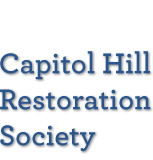Beyond the Boundaries
Posted on September 1st, 2007
by Donna Hanousek
One of the CHRS Board’s newest and most exciting projects is working on historic preservation efforts with neighborhood groups who are just outside the historic district. This past spring, CHRS arranged for a Preservation Café on House History, which was of particular interest to those outside of the historic district who wished to conduct research on their buildings. CHRS also published a detailed introduction to building history in the May issue of the Hill Rag, entitled “Dating Your Old Building.”
In the southeast, CHRS worked with the Barney Circle Neighborhood Association and Will Hill to nominate the Hill East neighborhood the D.C. Preservation League’s (DCPL) Most Endangered List. On May 31, 2007, DCPL included to its endangered list for 2007, “Undesignated Row House Neighborhoods,” as represented by Columbia Heights, Eckington, and Hill East. A short write up on and photo of Hill East appears on the DCPL website and will appear in many “Most Endangered” press pieces. The DCPL is committed to work with the Barney Circle Neighborhood Association, CHRS, and the ANC 6B on outreach efforts within the community on the benefits of historic district designation. CHRS is also supporting the effort by the Barney Circle Watch Neighborhood Association in preparing the historic district nomination, and will help coordinate product review and arrange for co-sponsorships that will strengthen the nominations.
In the northeast, CHRS assisted with arranging for DC Historic Preservation Staff and materials to be available for a series of meetings that ANC 6C and 6A subcommittees held jointly to discuss historic preservation. The end result was agreement by ANC 6C to support a survey effort to document the historic resources in their neighborhood; it is anticipated that ANC 6A will also vote to support a survey effort at its June meeting. Over the summer and into the fall, CHRS will assist in developing the scope of work and budget for the project, soliciting the bids, and negotiating the contracts with the consultant for the work.
Looking ahead, for both northeast and southeast, CHRS is working on a mapping project that will show when the areas outside the historic district were developed. The resulting product will be a visual aid that will be useful in researching any neighborhoods outside the historic district and will help to understanding the development patterns of greater Capitol Hill. In addition, for the first time, CHRS intends to focus on buildings that are beyond the boundaries of the Capitol Hill Historic District for next year’s house tour—stay tuned to our web site (CHRS.org) and the Hill Rag for more details later this year. Finally, CHRS has proposed a panel session on the “Development Patterns Beyond the Boundaries of Capitol Hill” for the D.C. Historical Studies Conference to be held in early November—if this session is accepted, we will post the details to our web site soon.


